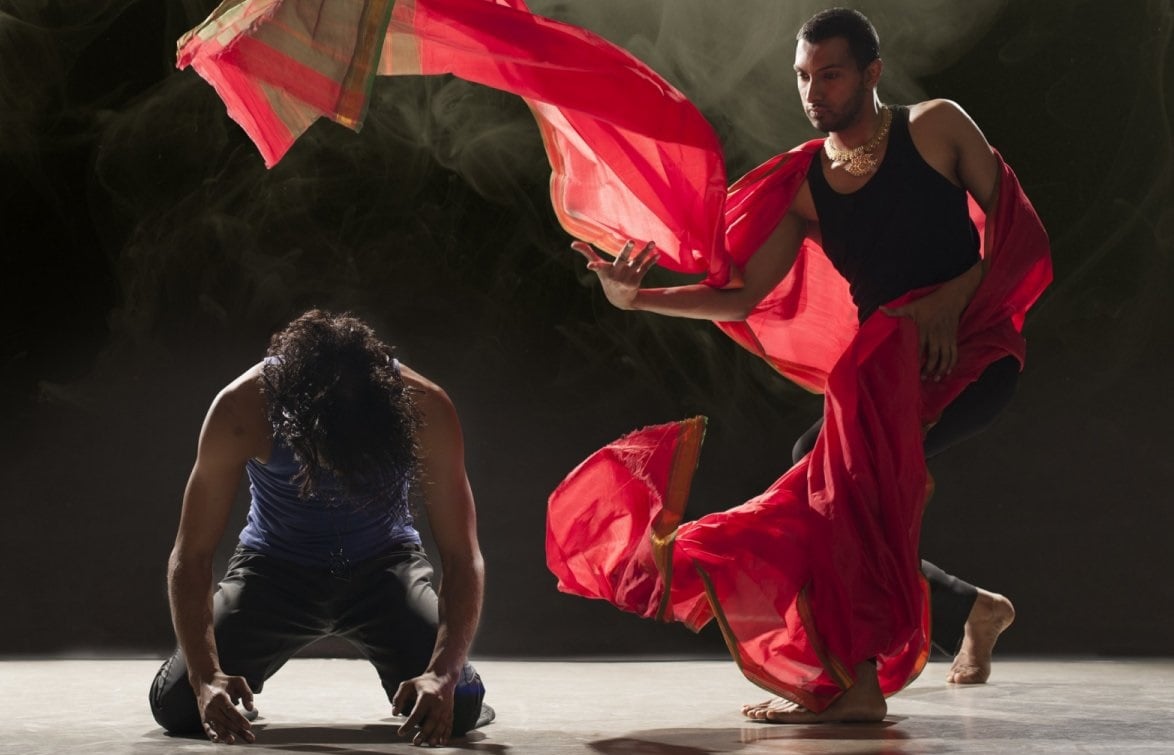
Material Men Redux
Photo: Chris Nash
Juggling and jigsaws
As a small company with no permanent dancers, Shobana Jeyasingh Dance productions are tricky to coordinate but ultimately rewarding. Amanda Skoog explains how they manage it.
All the Shobana Jeyasingh Dance productions are entirely new works developed from scratch. The ideas primarily come from Shobana and given her very diverse spread of interests each work is different. She might be curious about an element of scientific research or the music from a Monteverdi opera, or sometimes starting points come from venues, festivals or commissioners who have an idea or a particular site to animate.
It’s often difficult for freelance dancers to commit to a project that doesn’t have a full tour schedule confirmed from the start
We’re a very small team with only four full-time equivalent staff. Getting a production off the ground is a particular challenge when there isn’t a permanent company of dancers, production staff, nor a studio base. You don’t do less because you’re small – arguably, you do a lot more.
The juggling begins
Once an idea gets the go-ahead from Shobana and we can make sense of the budget, we start the research and development process. And so the juggling begins. We find out who might be available from the pool of dancers with whom we like to work, then we find rehearsal space and Shobana brings in various collaborators she’s interested in working with. On a recent R&D project they included dancers, musicians, composers, designers, virologists, digital artists and art historians.
The scale and context are one of the first things that determine the route of Shobana’s research, with the budget, scope and venue always in mind. After an R&D period, Shobana will decide on the final direction to go in, specifically the dancers and creative team.
The next step for me is to confirm artists. It’s often difficult for freelance dancers to commit to a project that doesn’t have a full tour schedule confirmed from the start. It is a moveable feast for a bit longer than I’d like and something we are working on.
Having said that, our latest production Material Men Redux started with something that already existed (it’s a full-length work based on the 2015 production), but that brought its own challenges. The original show, a Southbank Centre commission, was well reviewed but not widely seen. I felt we could build on that to get a really good tour together, which would help us develop our audiences in the regions and maximise our investment in the work.
The fact that we started with something that existed was a great help with the marketing but we had to secure the two dancers – Sooraj Subramaniam and Shailesh Bahoran, both in huge demand as soloists. Balancing the dates available at the tour venues with dates when the dancers were available was a real jigsaw puzzle.
The show is unusual in that the majority of the team is based offshore, so all the rehearsals took place in Amsterdam, which become a challenge in itself. For example, simple things like storing kit overnight, organising costume fittings via Skype and recording voiceovers with the dancers, composers and sound artists in three different countries was a bit of a nightmare.
Attracting an audience
Once the tour is in place, we need to attract audiences. We balance a growing social media and digital strategy with as much support as we can from our tour venues. Working in partnership with venues and commissioners is central, as it is their audience we are trying to bring in and build.
We produce striking imagery, working with some of the best dance photographers and designers out there. We don’t have specialist in-house marketing staff – that falls to me and the administrator, but we do work with social media and PR experts to develop and build the company’s relationship with audiences, the dance and wider arts community, and the media.
Our learning and participation programme is vital. As we usually only do one or two nights at each venue, school and community projects are crucial to encouraging and supporting interest in dance and the production. It enables us to make a greater impact and a positive difference from a short stay.
Building blocks in place
Coming from the Royal New Zealand Ballet, which has a regular touring pattern and substantial resources at its fingertips, has certainly provided me with the new ventures I was seeking. But in spite of (or perhaps because of) the challenges of working in this organic way, it is satisfying when everything comes together, when the building blocks slot into place, and we take Shobana’s work around the country.
Amanda Skoog is Executive Director of Shobana Jeyasingh Dance.
www.shobanajeyasingh.co.uk
Join the Discussion
You must be logged in to post a comment.